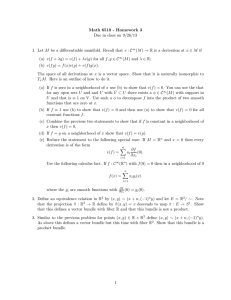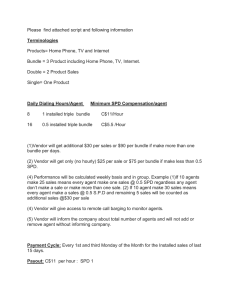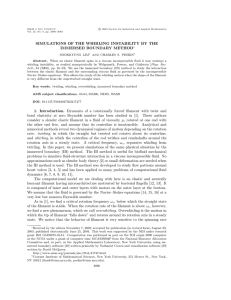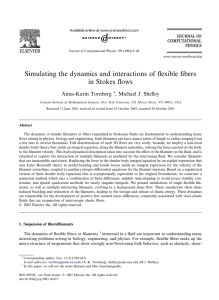Biophysics: Problems I N T
advertisement
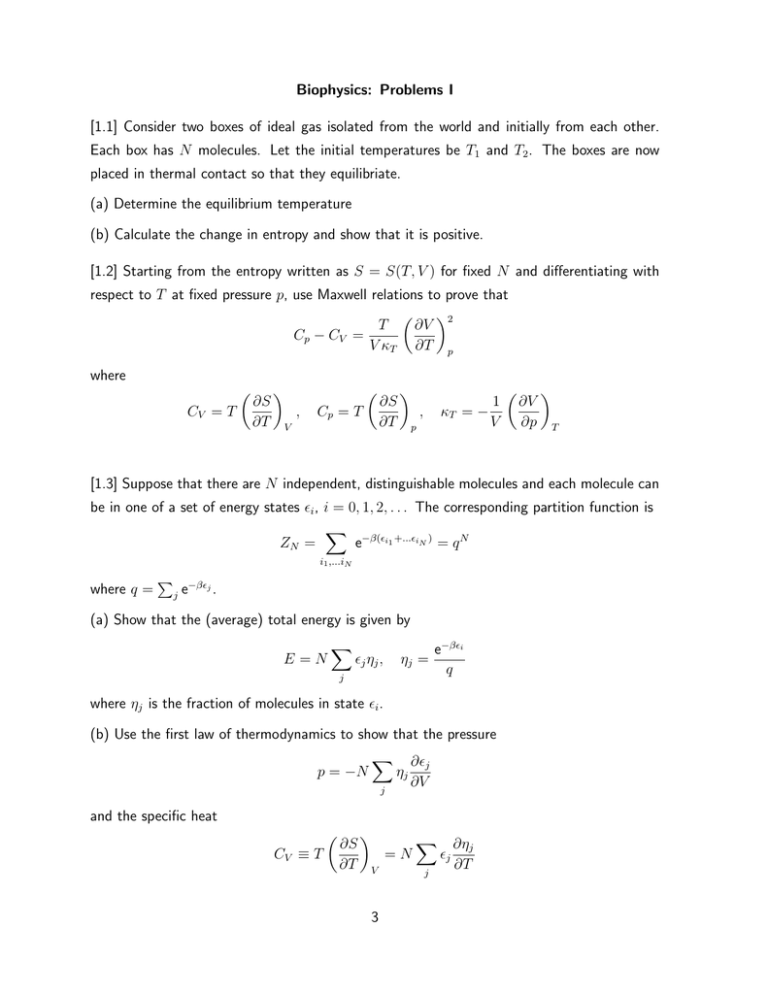
Biophysics: Problems I [1.1] Consider two boxes of ideal gas isolated from the world and initially from each other. Each box has N molecules. Let the initial temperatures be T1 and T2 . The boxes are now placed in thermal contact so that they equilibriate. (a) Determine the equilibrium temperature (b) Calculate the change in entropy and show that it is positive. [1.2] Starting from the entropy written as S = S(T, V ) for fixed N and differentiating with respect to T at fixed pressure p, use Maxwell relations to prove that 2 T ∂V Cp − CV = V κT ∂T p where CV = T ∂S ∂T , Cp = T V ∂S ∂T 1 κT = − V , p ∂V ∂p T [1.3] Suppose that there are N independent, distinguishable molecules and each molecule can be in one of a set of energy states i , i = 0, 1, 2, . . . The corresponding partition function is ZN = e−β(i1 +...iN ) = q N i1 ,...iN where q = j e−βj . (a) Show that the (average) total energy is given by E=N j ηj , ηj = j e−βi q where ηj is the fraction of molecules in state i . (b) Use the first law of thermodynamics to show that the pressure p = −N j and the specific heat CV ≡ T ∂S ∂T ηj ∂j ∂V =N V 3 j j ∂ηj ∂T Evaluate the latter to obtain the result CV = N 2 − 2 kB T 2 (c) Calculate q, E, CV in the case where the energy states of a molecule are given by n = (n + 1/2)hν, n = 0, 1, 2, . . . (These correspond to the energy states of a quantum harmonic oscillator with natural frequency ν). Determine the the behavior of E, CV in the small T and high T limits. [1.4] Classical ideal gas. The partition function for N indistinguishable molecules with kinetic energies p2 /2m and potential energies u(r) is ZN = 1 N q N! where q is the single molecule partition function 1 βp2 q = 3 exp − − βu(r) d3 pd3 r h 2m The probability density of molecules in a phase–space volume element d3 pd3 r/h3 is given by the corresponding Boltzmann distribution ρ(r, p) = q −1 βp2 exp − − βu(r) 2m (a) Evaluate ZN in the case u ≡ 0. Show that E = 3N kB T /2 and derive the ideal gas law p = N kB T /V . (b) Let v = (vx , vy , vz ) be the velocity of an individual molecule so that p = mv. Using the Boltzmann distribution calculate the following averages: vx , vx2 , and vx2 + vy2 + vz2 . (c) Using the Boltzmann distribution, calculate the density profile of an ideal gas in a vertical column under gravity. Show that the pressure at a given height obeys the ideal gas law. [1.5] A rubber band heats up when it is stretched slowly and adiabatically (no heat flow). Given this fact, determine whether it will contract or expand when it is cooled at constant tension. 4 [1.6] Signal transduction in the inner ear. The bundle of stiff fibres (called stereocilia) projecting from an auditory inner hair cell sway when the surrounding fluid moves. Displacement of the bundle causes a relative motion between neighboring stereocilia in the bundle, stretching a thin filament joining them (called the tip link) . At large displacements, the tension can cause a “trap door” to open (see figure 1a). Fgure 1b shows the force exerted by the hair bundle in response to experimentally imposed displacements. This shows that the bundle behaves like a simple spring at small and large deflections, but in the middle it has a region of negative stiffness. (A simple spring has a stiffness k = df /dx that is a positive constant). (a) (c) (b) ka f kb x δ The system can be modeled along the lines shown in figure 1c. The bundle of stereocilia can be treated as a collection of N elastic units in parallel. Each element has two springs. One, with spring constant ka and equilibrium position xa , represents the elasticity of the tip link filament. The other, with parameters kb , xb represents the stiffness of the bundle’s attachment point (provided by actin filaments). The first spring attaches via a hinged element (trap door). When the hinge is in its open state, the attachment point is a distance δ to the left of its closed state. The trap door is a two–state thermodynamic system with a free energy change ∆F0 to jump to its open state. (a) Let x be the total displacement of the bundle. Calculate the force fclosed (x) on an element 5 that is in a closed state. Calculate the corresponding force fopen (x) on an element that is in an open state. (b) Calculate the free energy difference ∆F (x) between an element’s two states (at fixed x). This will involve contributions from ∆F0 and the energy stored in the springs. Use this to determine the probability Popen that an element is in its open state, assuming that the N elements are in thermodynamic equilibrium with a heat bath at temperature T . (c) Using parts (a) and (b), show that the expected total force exerted by the N elements is of the form ftot (x) = Ktot x + f0 − Nz 1+ e−z(x−x0 )/kB T and find the quantities Ktot , f0 , z and x0 in terms of the given parameters. (d) Taking N = 65, Ktot = 1.1pN nm−1 , x0 = −2.2nm and f0 = 25pN graph the function ftot (x). Find a value of z for which the curve resembles the data. Assuming that ka = 2 × 10−4 N m−1 find δ. Is this a reasonable value? 6


